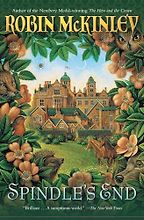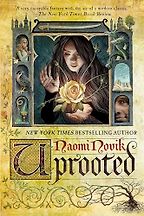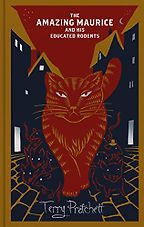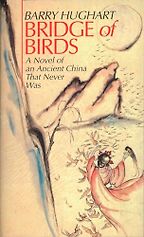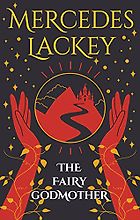Before we discuss your choices today – five fantasy books that retell or reimagine fairy tales – should we talk about what a fairy tale is?
This is a very complicated question: what is a fairy tale and what isn’t? It depends where you’re standing. I’m sure that a lot of things that we consider mythology now would have been fairy tales at the time, or religion, but the line blurs the farther you get away from it. A lot of things that we think of as Greek myths were probably fairy tales then: for example, ‘Cupid and Psyche,’ which shows up in Apuleius’ The Golden Ass, is the prototype of ‘East of the Sun, West of the Moon,’ and a whole bunch of other fairy tales.
So what is a fairy tale? Why and when does it become ancient Greek literature? And why are Hans Christian Andersen’s works fairy tales? He definitely wrote fairy tales, but other modern authors are not categorised that way. It’s a very mushy category. But—like pornography—you know it when you see it; that’s the only working definition. When it feels like a fairy tale. And I suppose it’s when it feels like something I read when I was a kid, which obviously is a very personal thing.
A lot of these have resonance, I think, because we were exposed to them as children. Many of us read fairy tales as a kid, or grew up on Disney – which has made an empire out of fairy tales – and I hate being driven to praise the Mouse, but they have done amazing work keeping a lot of these stories alive, even if they’re not the Brothers Grimm. There are much worse retellings! And if you grew up on Disney’s Beauty and the Beast, and then graduate to Angela Carter, the resonance is still there – because there’s an experience set very deep in your foundations.
Also, there are some stories that are definitely fairy tales, which don’t work. There was a book that came out a while back called The Turnip Princess and Other Stories, which was a volume of translations of fairy tales from German, contemporary with the Grimms. I read it and, quite frankly, you start to understand why they didn’t make the cut. A lot of them weren’t very good, or were repetitive: okay, this is this just Beauty and the Beast again, or this is Cupid and Psyche. Or stories that were just nonsensical – and a lot of fairy tales are nonsensical. Let’s give the Grimm’s credit for editing for coherency!
Yes. This raises the fact that retellings are not a modern phenomenon: we’ve always retold fairy tales.
Oh, definitely! A lot of these stories we have been retelling for ages, across cultures even. It seems to be that some stories are – well, I don’t want to say universal, because that brings exceptions – but some stories have clearly travelled a lot, and are rooted in the human psyche. We wind up retelling versions of these, a lot.
Your first choice is a version of a story that has been retold many times: ‘Sleeping Beauty.’ Could you introduce us to Spindle’s End by Robin McKinley?
Robin McKinley has written a lot of fairy tale retellings. Rose Daughter is still one of my favourite Beauty-and-the-Beasts. Spindle’s End is just a great Sleeping Beauty story.
It starts with the fairy godmother, who is very young, acquiring the princess just as she has been cursed, and having to keep her safe. The fairy godmother is about thirteen, and the princess – Rosie – is a newborn. The fairy godmother spirits Rosie away to avoid the curse.
You really feel for this girl! She’s trying to get back home. And she can talk to animals, that’s her main gift. As she grows up, she becomes not very princess-like: she’s not terribly attractive, and she works as a horse doctor. But meanwhile, the curse is looking for her, and eventually, it all comes together.
It’s really well done, it’s one of my very favourite retellings. And there are talking animals, which I’m a sucker for in anything.
I assume that in outline this is the modern ‘Sleeping Beauty’ we’re familiar with, and not one of the more disturbing versions of the original tale out there?
Yes, not the old-school, ‘oh my god, the prince did what?’ kind! In fact, the prince does show up, but he falls in love with the wrong person. I don’t want to say too much for spoilers, but it hangs together very well, and gets into some surreal territory – it’s delightful. And no horrible content warnings need apply, as they probably do to the original Sleeping Beauty, which is dark as hell.
There’s more than one book on your list today that plays around with the kinds of hero we follow. Here the princess isn’t Princess-like… It feels like that’s a major use of these retellings.
Yes absolutely! And changing who is involved: what if this story happened to someone else? Or what if I just focus on a different character – which gets us Maleficent, and a lot of others, where it’s about the evil godmother or the good godmother or whoever. And what if this is not the princess of legend? What if this story is happening to someone who is different? Older or wiser or a different gender… There are lots of modern retellings that turn the story on its head, and focus on different parts of the narrative.
The hero is the ‘wrong person’ in your next choice too – could you introduce us to Uprooted by Naomi Novik, the second fantasy book drawn from a fairy tale that you’d like to recommend?
Uprooted is based on Polish folklore. It’s sort of ‘Beauty and the Beast,’ and it’s also sort of feeding the maiden sacrifice to the dragon… A lot of fairy tales bleed together and have elements of other things in them. In this one, the heroine is the sacrifice. She jumps in front of her friend who is supposed to be the one the dragon picks, and so he picks her – he says, sure, whatever, I don’t care.
The dragon is a wizard. Every seven years he comes down and takes a girl from one of the villages in his land, and nobody knows what happens to her; she goes off, and she’s never seen it again, so people are assuming all kinds of horrible things. But it turns out all he wants is a housekeeper. He’s this surly, kind-of-traumatised magician, and he’s trying to keep an evil forest on the borders at bay. He’s fighting a holding action against it.
Much of the book is the heroine coming into her own power, learning that she has her own magical talents. As she becomes more powerful, she has to go and save her friend, who has been taken by the forest. The forest itself is creepy and dark and wonderfully written. Probably the part I love most, as a gardener, is that there are giant stick insects in it, which is just awesome. Everybody goes for a praying mantis, nobody ever goes for stick insects. I loved that.
Is the wood also part of Polish folklore?
That I couldn’t tell you, I’m not an expert on Polish folklore. But forests as dark, evil, scary places are a very common trope in folklore. At the time, they were full of wolves and bears and bandits, so they really were dangerous places. So it was often a contrast between the forest – which is scary and dangerous and untamed – and civilisation, the village, which is safe. We can certainly quibble over how safe civilisation is or how dangerous the forest is, but that was definitely the dichotomy. Look at ‘Little Red Riding Hood’ – the entire moral is: ‘Don’t go into the woods, kids.’ And also: ‘Don’t trust smooth-talking wolves’, I suppose…
Most of your fantasy book recommendations stay in the nature-infused world of fairy tales, but your next choice is much more urban, and much less mythic – could you tell us about Terry Pratchett’s The Amazing Maurice and His Educated Rodents?
Yes, The Amazing Maurice is very much about civilization! It’s a retelling of ‘The Pied Piper.’ In that story, the guy comes to town and promises to get rid of the rats, and he plays the flute and all the rats leave after him; then he comes back to ask for payment, and the village refuses. So he plays his pipe and all the children vanish. It’s basically a cautionary tale about paying your contractors.
In The Amazing Maurice, the rats can talk, they’re intelligent – they’re Rats of NIMH level – and, because it’s a Terry Pratchett book, they have eaten magical waste at the Unseen University and become smarter. There’s a cat who’s a mover and shaker, who is also intelligent, and is basically the manager; and there’s the kid who plays the flute. It’s all a scam: they come in, the rats take over, then the kid comes in and offers to get rid of them. And because the rats of course are in on it, they follow the kid out.
“I love that, however weird as they get, there’s still something in fairy tales that plucks a string in your psyche”
The problem arises when eventually the rats say: ‘We’re tired of this, we want to settle down. We want be recognised as intelligent, and be productive members of society.’ The cat is very conflicted about this for reasons of his own.
In the way that Pratchett does so well, it’s about the problems of society. Can a town adapt to having rat citizens? What is going to go wrong? Can they sit down and talk about it and get over it? And because Pratchett’s very good, it’s no spoiler to say it does end well – but there’s a lot of dark things that happen along the way. There is a very nasty monster and an unlikely rat hero… It’s beautifully put together.
Pratchett described it himself as the story based on the novel concept that people can talk out their problems. I love that! It doesn’t always have to be the big heroic battle at the end. Sometimes it can just be, ‘Let’s sit down at the negotiating table.’
It stands out on your list to me as one that feels less like a fairy tale, even though it is directly based on one.
Yes. While it is definitely based on a fairy tale, it pulls almost all of the elements into the real world – well, you know, the real Discworld – and plays them all very straight. Magic is a force that is understood; it doesn’t have the kind of weird, surreal, dreamlike quality that a lot of fairy tales do. This is very much a thing that is happening to real people, that they are dealing with; it’s very solidly rooted in reality.
Could you talk a little more about that dreamlike quality? I agree that fairy tale magic always feels that way.
Magic in fairy tales is not like the magic system of Dungeons & Dragons, or of those fantasy novels where everything is set down and very clearly structured. It is a weird force that just happens. Why does the curse mean that the hero will stay a beast all day, but turn back at night? Why do spots of blood on a handkerchief talk? Why does a dead horse skull talk to the hero? Magic is weird, and it’s not explained; it’s just a force that is there and does stuff. And sometimes it does stuff that’s convenient for the plot, but sometimes it also just sits in the fairy tale as just a weird-ass thing that happens.
One of the fairy tales in The Turnip Princess is a very straightforward ‘East of the Sun, West of the Moon’ version, but the hero turns into a stone lion statue all day. Why? Because he does, and that’s just how it is. Why is there a spinning wheel inside a walnut? Because somebody put it there, that’s just how these things go. You don’t stop the whole narrative and say, hang on a minute, what happened there? The way that you do in a lot of other genres.
Fantasy as a genre has two camps: in one, if there’s a spinning wheel in a walnut you just say: Magic did it. In the other, you say: Hold the phone, we’re going to need an explanation. Who put it there? What’s going on? Is there an entire guild of spinning-wheel-and-walnut makers? Then, a lot of them would sit down and explain the history of this guild, the training that you have to undergo to become a licenced spinning-wheel-and-walnut-maker, and so on. So those are the two camps in fantasy – is the magic explained, or is it just this elemental background force that you are subjected to.
And in Terry Pratchett’s hands, the detailed explanations are often humorous. This discussion of fairy tale style makes me think of your book Nettle and Bone, which won the 2023 Hugo Award. It doesn’t retell a particular fairy tale, but it feels overwhelmingly like one. I think a lot of that comes from the strangeness of the magic, and how well it works on a symbolic level. Were you drawing on tales you knew, or is this all invention?
A little from column A and a little from column B. Nettle and Bone started out, of all things, from ‘The Princess and the Pea,’ which is a ridiculous fairy tale that seems very funny. It makes a great children’s story; you can do great illustrations. It’s about a princess who sleeps on a pile of a hundred mattresses, but there’s a pea under the bottom one. She can’t sleep, she’s tossing and turning, she’s got bruises on her back – and that’s how the prince knows she’s a real princess. It’s a very lighthearted fairy tale on the surface. Then you start to ask questions like, why does the prince wants a princess who bruises so easily, and is so sensitive? And it gets really unpleasant really fast. Terry Windling has done some amazing stories – and anthologies, as an editor – about the places that fairytales go very bad, and very, very gnarly. So that was where I started.
That led me to the question: What do you do when the prince is the bad guy? What if he has all the power, and he’s messing with your sister, and you want to save her? What are you going to do? Which led me to Nettle and Bone. Mara, the heroine, wants to figure out how to save her sister, who is being abused by the prince. She goes on a quest, and a lot of it has a fairytale resonance.
Five Books interviews are expensive to produce. If you're enjoying this interview, please support us by donating a small amount.
The questing always come in threes – although is that fairy tales, or is that just storytelling in general? The three-act structure? I drew on a lot of that. Sometimes it uses random imagery that I thought was interesting… Writers have brains like magpies – actually, I should say European magpies, because I was just in Australia and their magpies are very different – in that they collect shiny objects and stash them in their nest. You don’t really know a lot of times where some of the stuff at the bottom came from; you’ve long forgotten. Some of the imagery is probably lifted from a story I read thirty years ago, and some of it was just stuff that I thought would be cool.
There was the woman being controlled by a puppet on her shoulder – that really stuck with me…
puppets are creepy. The woman with the puppet was purely me saying: ‘Wouldn’t this be really unpleasant? I can do this and no one can stop me.’ That’s a lot of what being a writer is. Well, being a writer for adults. When I was writing for kids, people stopped me all the time.
There were old elements in there too. The goblin market, if not actually a fairy tale, was a poem and is in our cultural Gestalt enough that it feels resonant on some of the same levels. And fairy godmothers have been around a lot; I had a lot of fun with fairy godmother characters. But once I was past ‘The Princess and the Pea,’ there wasn’t a specific fairy tale that the whole story is based on. It was just places I went, having a handful of fairy tales in my head, and one really boring job at the streetlight outage hotline in St. Paul, Minnesota, where they did not track our web usage. I just had to sit by the phone and wait for people to call to say their streetlight was out.
So I spent all of it on the University of Pittsburgh folklore and mythology archive, which is web 1.0 HTML links to things like ‘50 animal bridegroom stories’, all in a list.
Your latest book Thornhedge is more directly based on Sleeping Beauty – although you combine this with British water mythology. Can you introduce us to the book, and talk a little about your sources?
Yes! I actually came up with it because at the time I was writing a children’s book retelling of ‘Sleeping Beauty’ called Hamster Princess, where the heroine is basically Xena the Warrior Princess, only as a hamster. She uses the fact that she’s going to fall asleep when she turns twelve. Okay, she says, the magic has to keep me safe until then, so I am now effectively invincible. She takes up cliff diving – she’s a fun character, she’s very fierce.
At the same time as I was working on this, my brain was saying: ‘You could go the completely opposite way, you know…’ And so I wound up starting this other story on the side – probably to the detriment of my deadline – where the heroine is not fierce at all. She is she is very meek and timid, and she is essentially the fairy godmother who curses the princess. Unlike in Maleficent, which is a retelling that I love, she is not scary or hardcore. She is just trying to do her job, and she’s afraid she’s doing everything wrong. I relate to that a lot! I am frequently trying to do the right thing and trying to do my job and worried that it is all about to fall apart.
She’s a changeling from the other direction – she is the human infant who gets taken, and a changeling is left in her place. She gets thrown to the Greenteeth. Greenteeth are a British water monster: Jenny Greenteeth comes up and drags children into the water. I was just thinking what it would be like if you were raised by Greenteeth and how strange that would be. I had a lot of fun; the water monsters are actually kind of lovely, in a carnivorous, scary way. They love the heroine, and they teach her how to change into a toad, all sorts of things.
So she becomes only partly human, and she’s very happy where she is. Then she gets dragged away because she has to be the godmother at the christening, and she kind of screws it up. She winds up having to stay there and keep the infant, who is her changeling, from growing up to become as evil and capricious as fairies are in the old stories. They’re not cute little things: they’re horribly scary, arbitrary beings that will cheerfully turn you into a mat and step on you. So our heroine, the wicked fairy godmother, has to build the wall to keep in the monster.
It’s basically a story about the question: When is your job done? When do you get to stop, when have you have done enough? Which is a very hard thing for a lot of us to define. Where’s the endpoint to a terrible job, when it feels like you’re the only person who can do it? Is it fair to ask someone to spend the rest of their life doing this thing they didn’t ask for? It’s an exploration of that. And there’s a knight who is very sweet and charming. I loved writing him.
We have more fairy-tale godmothers in your next fantasy book recommendation: Mercedes Lackey’s The Fairy Godmother, the first book in her Five Hundred Kingdoms series. Could you tell us more?
The Five Hundred Kingdoms series is a little older… I don’t want to think about how old they are, because then I’ll have to calculate how old I am. But they were a set of fantasy romances before fantasy romance books were big. I’ll be honest: these are popcorn books, they are light and fluffy. These are not life-changing, deep books, but they are fun. And I firmly believe that there needs to be room for fun in the world.
It’s about a magic system is ruled by ‘the Tradition’, a sort of mindless force that is trying to cause fairy tale stories to occur. This is actually something that Pratchett talks about in Witches Abroad, that idea that story is a force that wants to follow familiar channels. This first one is about an apprentice fairy godmother, who is charged with caretaking the Tradition and making sure that the really horrible stories don’t happen; ‘Rapunzel,’ for example, is a terrible story with a high body count. As soon as it looks like one of these is starting to come true, it’s her job to push it into a more acceptable channel – make it more of a ‘Cinderella’ story, or something. The overall story is, in fact, ‘Cinderella’; but instead of becoming a princess, she becomes a fairy godmother.
It’s fun, it’s light, it’s fluffy. But there is the real sense that fairy tales are dark and scary, and they’re also stories that will want to happen. We’ve been talking about fairy tale plots that just keep coming up – ‘Beauty and the Beast’ gets repeated all the time, and all the variations on ‘Blue Beard.’
So, she’s a fairy godmother, and her eventual relationship is with someone who turns out to be a champion – you know, the dragon-slayer-knight type. These books are a great choice for when my brain is tired, and just I want to sit down and read wish-fulfilment happy popcorn. I am all for books like that, because when I’m writing a horror novel, it’s about the only thing I can read – because I can’t read whatever genre I’m writing.
Fairy godmothers keep recurring in our discussion today!
Yes! The fairy godmothers do a lot of work. They’re running things behind the scenes, they’re trying to orchestrate things. And they usually have to do it usually while being a frumpy, middle-aged woman – possibly with wings. As, myself, a frumpy, middle-aged woman – though not with wings – I can say that fairy godmothers are tired, dammit! Maybe that’s just the Gen-X fairy godmothers, I don’t know. But I feel like it needs to be acknowledged that these people are putting in a lot of work.
In Nettle and Bone, Agnes the fairy godmother was my favourite character and certainly the one that I related to the most. Oh God, I am Agnes.
We’ve only got one of your choices left: Bridge of Birds by Barry Hughart. Why do you recommend this particular fairy tale-inspired fantasy book?
Bridge of Birds is sort of 90º from the other things we’ve been discussing. It’s based on a Chinese folktale about a woman who is a minor god, and in order to ascend to heaven, every year, she can call on all the birds of China who will build a bridge to heaven out of their bodies, and she can climb it. The book is what happens when this goes bad, and someone steals the magical object that allows her to do that. It starts with frankly one of the most likeable narrators in all of fantasy, Number Ten Ox, who is big and who claims to be slow, but he is not. He’s a peasant, he has lived his whole life as a farmer, and he is not aware of a lot of political things or things going on in towns, so you get to experience this through his eyes – which is very clever, as it allows him to explain things without having to info-dump.
His mentor and friend, Master Li, is extremely intelligent but has a “slight flaw in his character,” as he says. It’s a fantastical, ridiculous romp. It’s not that long, but they’re travelling across China, and it has a Raiders of the Lost Ark, big budget movie feel – you know, escaping traps and giant invisible spiders and the evil who is chasing them. It’s a fantastical, ridiculous romp.
The author, I think, wound up getting a seven book deal or something, wrote two of them and then said; ‘No, I’m using this as a coping mechanism for my PTSD from Vietnam and I can’t do it anymore.’ Which was very sad.
That’s the last of your five recommendations. Thank you, it’s been such a pleasure to talk fairy tale fantasy books with you.
I love fairy tales! And not just because plots are hard to write, and when you’re retelling a fairy tale, it’s built in. I love how weird they get. And I love that, however weird as they get, there’s still something that plucks a string in your psyche, and makes you say: yes, this is important. I love that. It’s almost like a built-in cheat code for the soul. And if you tell it well, you slide in under the reader’s defences, back to when they were reading their very first books on their own.
Five Books aims to keep its book recommendations and interviews up to date. If you are the interviewee and would like to update your choice of books (or even just what you say about them) please email us at [email protected]


